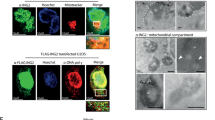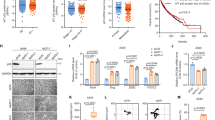Abstract
Mitochondrial alterations induced by oncogenes are known to be crucial for tumorigenesis. Ras oncogene leads to proliferative signals through a Raf-1/MEK/ERK kinase cascade, whose components have been found to be also associated with mitochondria. The mitochondrial pepdidyl-prolyl isomerase cyclophilin D (CypD) is an important regulator of the mitochondrial permeability transition and a key player in mitochondria physiology; however, its role in cancer is still unclear. Using cellular and in vivo mouse models, we demonstrated that CypD protein upregulation induced by oncogenic Ras through the Raf-1/MEK/ERK pathway has a deterministic role in tumor progression. In fact, targeting CypD gene expression clearly affected RasV12-induced transformation, as showed by in vitro data on murine NIH3T3 and human MCF10A mammary epithelial cells. In addition, studies in xenograft and K-Ras lung cancer mouse models demonstrated that genetic deletion or pharmacological suppression of CypD efficiently prevented Ras-dependent tumor formation. Furthermore, Erbb2-mediated breast tumorigenesis was similarly prevented by targeting CypD. From a mechanistic point of view, CypD expression was associated with a reduced induction of p21WAF1/CIP1 and p53 functions, unraveling an antagonistic function of CypD on p21–p53-mediated growth suppression. CypD activity is p53 dependent. Interestingly, a physical association between p53 and CypD was detected in mitochondria of MCF10A cells; furthermore, both in vitro and in vivo studies proved that CypD inhibitor-based treatment was able to efficiently impair this interaction, leading to a tumor formation reduction. All together, these findings indicate that the countering effect of CypD on the p53–p21 pathway participates in oncogene-dependent transformation.
This is a preview of subscription content, access via your institution
Access options
Subscribe to this journal
Receive 50 print issues and online access
$259.00 per year
only $5.18 per issue
Buy this article
- Purchase on Springer Link
- Instant access to full article PDF
Prices may be subject to local taxes which are calculated during checkout








Similar content being viewed by others
References
Wang P, Heitman J . The cyclophilins. Genome Biol 2005; 6: 226.
Javadov S, Kuznetsov A . Mitochondrial permeability transition and cell death: the role of cyclophilin d. Front Physiol 2013; 4: 76.
Elrod JW, Molkentin JD . Physiologic functions of cyclophilin D and the mitochondrial permeability transition pore. Circ J 2013; 77: 1111–1122.
Baines CP, Kaiser RA, Purcell NH, Blair NS, Osinska H, Hambleton MA et al. Loss of cyclophilin D reveals a critical role for mitochondrial permeability transition in cell death. Nature 2005; 434: 658–662.
Machida K, Ohta Y, Osada H . Suppression of apoptosis by cyclophilin D via stabilization of hexokinase II mitochondrial binding in cancer cells. J Biol Chem 2006; 281: 14314–14320.
Schubert A, Grimm S, Cyclophilin D . a component of the permeability transition-pore, is an apoptosis repressor. Cancer Res 2004; 64: 85–93.
Chen G, Izzo J, Demizu Y, Wang F, Guha S, Wu X et al. Different redox states in malignant and nonmalignant esophageal epithelial cells and differential cytotoxic responses to bile acid and honokiol. Antioxid Redox Signal 2009; 11: 1083–1095.
Downward J . Targeting RAS signalling pathways in cancer therapy. Nat Rev Cancer 2003; 3: 11–22.
Schubbert S, Shannon K, Bollag G . Hyperactive Ras in developmental disorders and cancer. Nat Rev Cancer 2007; 7: 295–308.
Castellano E, Downward J . RAS interaction with PI3K: more than just another effector pathway. Genes Cancer 2011; 2: 261–274.
Wang HG, Rapp UR, Reed JC . Bcl-2 targets the protein kinase Raf-1 to mitochondria. Cell 1996; 87: 629–638.
Neuzil J, Rohlena J, Dong LF . K-Ras and mitochondria: dangerous liaisons. Cell Res 2012; 22: 285–287.
Yagoda N, von Rechenberg M, Zaganjor E, Bauer AJ, Yang WS, Fridman DJ et al. RAS-RAF-MEK-dependent oxidative cell death involving voltage-dependent anion channels. Nature 2007; 447: 864–868.
Longo VD . Ras: the other pro-aging pathway. Sci Aging Knowledge Environ 2004; 2004: pe36.
Kang BH, Plescia J, Dohi T, Rosa J, Doxsey SJ, Altieri DC . Regulation of tumor cell mitochondrial homeostasis by an organelle-specific Hsp90 chaperone network. Cell 2007; 131: 257–270.
Serrano M, Lin AW, McCurrach ME, Beach D, Lowe SW . Oncogenic ras provokes premature cell senescence associated with accumulation of p53 and p16INK4a. Cell 1997; 88: 593–602.
Hingorani SR, Wang L, Multani AS, Combs C, Deramaudt TB, Hruban RH et al. Trp53R172H and KrasG12D cooperate to promote chromosomal instability and widely metastatic pancreatic ductal adenocarcinoma in mice. Cancer Cell 2005; 7: 469–483.
Tsumura H, Yoshida T, Saito H, Imanaka-Yoshida K, Suzuki N . Cooperation of oncogenic K-ras and p53 deficiency in pleomorphic rhabdomyosarcoma development in adult mice. Oncogene 2006; 25: 7673–7679.
Zheng S, El-Naggar AK, Kim ES, Kurie JM, Lozano G . A genetic mouse model for metastatic lung cancer with gender differences in survival. Oncogene 2007; 26: 6896–6904.
DuPage M, Dooley AL, Jacks T . Conditional mouse lung cancer models using adenoviral or lentiviral delivery of Cre recombinase. Nat Protoc 2009; 4: 1064–1072.
Marchenko ND, Zaika A, Moll UM . Death signal-induced localization of p53 protein to mitochondria. A potential role in apoptotic signaling. J Biol Chem 2000; 275: 16202–16212.
Murphy ME, Leu JI, George DL . p53 moves to mitochondria: a turn on the path to apoptosis. Cell Cycle 2004; 3: 836–839.
Galluzzi L, Morselli E, Kepp O, Vitale I, Pinti M, Kroemer G . Mitochondrial liaisons of p53. Antioxid Redox Signal 2011; 15: 1691–1714.
Halestrap AP, Davidson AM . Inhibition of Ca2(+)-induced large-amplitude swelling of liver and heart mitochondria by cyclosporin is probably caused by the inhibitor binding to mitochondrial-matrix peptidyl-prolyl cis-trans isomerase and preventing it interacting with the adenine nucleotide translocase. Biochem J 1990; 268: 153–160.
Pantoja C, Serrano M . Murine fibroblasts lacking p21 undergo senescence and are resistant to transformation by oncogenic Ras. Oncogene 1999; 18: 4974–4982.
Gambino V, De Michele G, Venezia O, Migliaccio P, Dall'Olio V, Bernard L et al. Oxidative stress activates a specific p53 transcriptional response that regulates cellular senescence and aging. Aging Cell 2013; 12: 435–445.
Sperka T, Wang J, Rudolph KL . DNA damage checkpoints in stem cells, ageing and cancer. Nat Rev Mol Cell Biol 2012; 13: 579–590.
Hansson MJ, Mattiasson G, Mansson R, Karlsson J, Keep MF, Waldmeier P et al. The nonimmunosuppressive cyclosporin analogs NIM811 and UNIL025 display nanomolar potencies on permeability transition in brain-derived mitochondria. J Bioenerg Biomembr 2004; 36: 407–413.
Bamford S, Dawson E, Forbes S, Clements J, Pettett R, Dogan A et al. The COSMIC (Catalogue of Somatic Mutations in Cancer) database and website. Br J Cancer 2004; 91: 355–358.
Harari D, Yarden Y . Molecular mechanisms underlying ErbB2/HER2 action in breast cancer. Oncogene 2000; 19: 6102–6114.
Hoeflich KP, O'Brien C, Boyd Z, Cavet G, Guerrero S, Jung K et al. In vivo antitumor activity of MEK and phosphatidylinositol 3-kinase inhibitors in basal-like breast cancer models. Clin Cancer Res 2009; 15: 4649–4664.
Jiang K, He B, Lai L, Chen Q, Liu Y, Guo Q et al. Cyclosporine A inhibits breast cancer cell growth by downregulating the expression of pyruvate kinase subtype M2. Int J Mol Med 2012; 30: 302–308.
Abel EL, Angel JM, Kiguchi K, DiGiovanni J . Multi-stage chemical carcinogenesis in mouse skin: fundamentals and applications. Nat Protoc 2009; 4: 1350–1362.
Zhao Y, Oberley TD, Chaiswing L, Lin SM, Epstein CJ, Huang TT et al. Manganese superoxide dismutase deficiency enhances cell turnover via tumor promoter-induced alterations in AP-1 and p53-mediated pathways in a skin cancer model. Oncogene 2002; 21: 3836–3846.
Kumar P, Mark PJ, Ward BK, Minchin RF, Ratajczak T . Estradiol-regulated expression of the immunophilins cyclophilin 40 and FKBP52 in MCF-7 breast cancer cells. Biochem Biophys Res Commun 2001; 284: 219–225.
Scheffner M, Werness BA, Huibregtse JM, Levine AJ, Howley PM . The E6 oncoprotein encoded by human papillomavirus types 16 and 18 promotes the degradation of p53. Cell 1990; 63: 1129–1136.
Rasola A, Sciacovelli M, Chiara F, Pantic B, Brusilow WS, Bernardi P . Activation of mitochondrial ERK protects cancer cells from death through inhibition of the permeability transition. Proc Natl Acad Sci USA 2010; 107: 726–731.
Hursting SD, Shen JC, Sun XY, Wang TT, Phang JM, Perkins SN . Modulation of cyclophilin gene expression by N-4-(hydroxyphenyl)retinamide: association with reactive oxygen species generation and apoptosis. Mol Carcinog 2002; 33: 16–24.
Beltrami E, Ruggiero A, Busuttil R, Migliaccio E, Pelicci PG, Vijg J et al. Deletion of p66Shc in mice increases the frequency of size-change mutations in the lacZ transgene. Aging Cell 2013; 12: 177–183.
Adams JM, Cory S . The Bcl-2 protein family: arbiters of cell survival. Science 1998; 281: 1322–1326.
Luvisetto S, Basso E, Petronilli V, Bernardi P, Forte M . Enhancement of anxiety, facilitation of avoidance behavior, and occurrence of adult-onset obesity in mice lacking mitochondrial cyclophilin D. Neuroscience 2008; 155: 585–596.
Vaseva AV, Marchenko ND, Ji K, Tsirka SE, Holzmann S, Moll UM . p53 opens the mitochondrial permeability transition pore to trigger necrosis. Cell 2012; 149: 1536–1548.
Zhao LP, Ji C, Lu PH, Li C, Xu B, Gao H . Oxygen glucose deprivation (OGD)/re-oxygenation-induced in vitro neuronal cell death involves mitochondrial cyclophilin-D/P53 signaling axis. Neurochem Res 2013; 38: 705–713.
Holley AK St, Clair DK . Watching the watcher: regulation of p53 by mitochondria. Future Oncol 2009; 5: 117–130.
Holley AK, Dhar SK St, Clair DK . Manganese superoxide dismutase versus p53: the mitochondrial center. Ann NY Acad Sci 2010; 1201: 72–78.
Senturk S, Yao Z, Camiolo M, Stiles B, Rathod T, Walsh AM et al. p53Psi is a transcriptionally inactive p53 isoform able to reprogram cells toward a metastatic-like state. Proc Natl Acad Sci USA 2014; 111: E3287–E3296.
Masuo T, Okamura S, Zhang Y, Mori M . Cyclosporine A inhibits colorectal cancer proliferation probably by regulating expression levels of c-Myc, p21(WAF1/CIP1) and proliferating cell nuclear antigen. Cancer Lett 2009; 285: 66–72.
Zupanska A, Dziembowska M, Ellert-Miklaszewska A, Gaweda-Walerych K, Kaminska B . Cyclosporine a induces growth arrest or programmed cell death of human glioma cells. Neurochem Int 2005; 47: 430–441.
Rapino S, Marcu R, Bigi A, Soldà A, Marcaccio M, Paolucci F et al. Scanning electrochemicalmicroscopy reveals cancer cell redox state. Electrochimica Acta 2015; 179: 65–73.
Hogan B, Beddington R, Costantini F, Lacey E . Manipulating the Mouse Embryo. Cold Spring Harbor Laboratory Press: USA, 1994.
Todaro GJ, Green H . Quantitative studies of the growth of mouse embryo cells in culture and their development into established lines. J Cell Biol 1963; 17: 299–313.
Guerra C, Mijimolle N, Dhawahir A, Dubus P, Barradas M, Serrano M et al. Tumor induction by an endogenous K-ras oncogene is highly dependent on cellular context. Cancer Cell 2003; 4: 111–120.
Debacq-Chainiaux F, Erusalimsky JD, Campisi J, Toussaint O . Protocols to detect senescence-associated beta-galactosidase (SA-betagal) activity, a biomarker of senescent cells in culture and in vivo. Nat Protoc 2009; 4: 1798–1806.
Marcu R, Rapino S, Trinei M, Valenti G, Marcaccio M, Pelicci PG et al. Electrochemical study of hydrogen peroxide formation in isolated mitochondria. Bioelectrochemistry 2012; 85: 21–28.
Li B, Chauvin C, De Paulis D, De Oliveira Fdr, Gharib A, Vial G et al. Inhibition of complex I regulates the mitochondrial permeability transition through a phosphate-sensitive inhibitory site masked by cyclophilin D. Biochim Biophys Acta 2012; 1817: 1628–1634.
Acknowledgements
This work was supported by the Italian Association for Cancer Research (AIRC) and the Fondazione Umberto Veronesi (FUV) grants awarded to MG. We thank Michael Forte and Paolo Bernardi for helpful discussion and for providing CypDKO mice, Mariano Barbacid for K-Ras/RERT mice, Jacob Tropmair for MEK-1 mutants and Novartis (Basel-Switzerland) for Deb025.
Author information
Authors and Affiliations
Corresponding author
Ethics declarations
Competing interests
The authors declare no conflict of interest.
Additional information
Supplementary Information accompanies this paper on the Oncogene website
Rights and permissions
About this article
Cite this article
Bigi, A., Beltrami, E., Trinei, M. et al. Cyclophilin D counteracts P53-mediated growth arrest and promotes Ras tumorigenesis. Oncogene 35, 5132–5143 (2016). https://doi.org/10.1038/onc.2016.42
Received:
Revised:
Accepted:
Published:
Issue Date:
DOI: https://doi.org/10.1038/onc.2016.42
This article is cited by
-
Human exposure to low dose ionizing radiation affects miR-21 and miR-625 expression levels
Molecular Biology Reports (2022)



